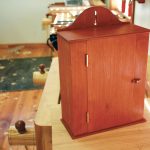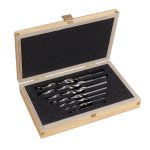We may receive a commission when you use our affiliate links. However, this does not impact our recommendations.
 In December I built a large traditional tool chest for my shop at home, and I couldn’t stop staring at the end grain of the wide pine planks I’d selected for the walls of the chest.
In December I built a large traditional tool chest for my shop at home, and I couldn’t stop staring at the end grain of the wide pine planks I’d selected for the walls of the chest.
Though I work with wood every day, the annular rings of these boards – some of them 18″ wide – were mesmerizing. Before I cut the dovetails on one of the panels I stopped to count its annular rings, tracing the growth history of the tree for more than 20 years.
Before that board came into my hands, it had sat in a barn for at least 10 years. So when this tree was busy building the cells that would eventually become my tool chest, I was 12 years old and just learning to use a coping saw and hammer.
As I did this little bit of math, I put my dovetail saw down for a moment and tried to figure out what that meant.
What other objects do we have in our houses that take so long to create? When I visit tool-making factories, I am stunned by how rapidly things are manufactured. Once I watched an injection-molding machine make the nylon shell of a random-orbit sander. I then watched a machine wind the motor. I watched a couple workers assemble all the pieces. And at the end of the factory tour my host presented the sander to me as a gift.
That tool is a small miracle – a testament to human ingenuity and industriousness. But it is also a symptom of a chronic sickness that we have lived with for so long that we don’t even remember what life was like before we were infected and weak.
The ability to fulfill our desires in mere moments has cheapened our appreciation for the labor required to make anything. Because mass-manufacturing has made goods so inexpensive, we are willing to throw away once-permanent objects – such as furniture – when we grow tired of the way it looks.
So naturally manufacturers respond by making even cheaper goods that are designed to last only a short time. Why build a bookcase to last 50 years when it will be kicked to the curb in five?
Honestly, I can’t live like that anymore. And I suspect that many woodworkers feel the same way, even if they don’t express it in the same way.
By building things that are designed to outlast us, we make ourselves the last holdouts of a proud tradition of craft that stretches back to the beginning of civilization.
So when you pick up your saw and clamp up a board that is as old as you, try to make every stroke count. You owe it to yourself, the tree and the whole of human history.
Here are some supplies and tools we find essential in our everyday work around the shop. We may receive a commission from sales referred by our links; however, we have carefully selected these products for their usefulness and quality.









I could not agree more.
BTW, thanks largely to your inspirational writing, most of my home is now furnished with stuff I’ve made, and which hopefully someone will enjoy when I’m long gone.
Lost Art Press will be appreciated for generations to come, I suspect.
Thanks Chris. For articulating my thoughts so succinctly.